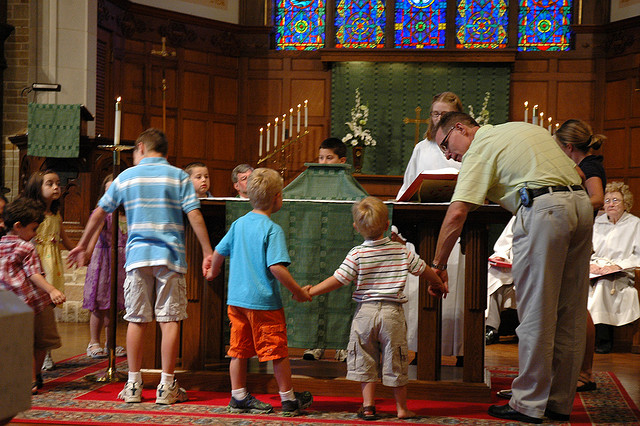Dear Working Preacher,
Here’s my simple suggestion for preaching this Sunday: do what Jesus did. That is, teach your people how to pray.
A short story gets at why. A local St. Paul congregation my colleague Rolf Jacobson attends has a “prayer partner” program. Maybe your congregation does, too. They pair up youth and elders in the congregation and invite them to pray for each other throughout the year. A couple of times a year, they also invite the pairs to sit together in worship. What Rolf noticed at one of the “prayer partner Sundays,” though, was that they don’t actually ever pray together. “They might as well call it, ‘Sit with your prayer partner Sunday,’” he quipped.
But of course he knew why they don’t actually have the prayer partners pray for each other: most of our people aren’t comfortable praying aloud for each other in public … or maybe even in private. We might say prayers to ourselves, say table grace, or read the prayers in the bulletin, but we don’t often say prayers aloud for each other. Why? Because most of us were never taught how. And, like most adults, our people are very uncomfortable doing things they haven’t developed some measure of competence in. Why else does the pastor always pray when invited to dinner? Because the pastor knows how; indeed, the pastor is the expert.
So why not use this Sunday when we read Luke’s version of the Lord’s Prayer as an opportunity to teach our people how to pray? If so, three observations about today’s passage might be helpful.
First, the Lord’s Prayer is pretty simple. After asking that we act in a way to keep God’s name holy and live the kingdom life on earth, Jesus’ prayer covers sustenance (daily bread), relationship (forgiveness), and safety (bringing us through the time of trial). These are the basics of life, and Jesus contains himself pretty much to these essentials. In short, prayer doesn’t need to be complex to be faithful.
Second, faithful prayer is honest. Jesus’ parable invites us to imagine that, like a man confident of his neighbor’s hospitality, we should ask for whatever we need. That means that prayer isn’t about saying the right words or sounding particularly eloquent or pious. Rather, it’s about saying what’s on our heart in our own words.
Third, prayer is based on trust. Jesus promises that just as we desire to give those we love good things, so does God even more want to give us every good gift. Because we trust this is true, we pray. This may be one of the most difficult parts of prayer, I know, because we often see prayers go unanswered. Yet we still trust that God is listening and we continue to pray because we believe God loves us and all the world. (Elizabeth Johnson has some helpful things to say about unanswered prayer in this week’s commentary, and I dealt more fully with this challenging element of prayer in my column three years ago.)
So that’s it: prayer is simple, honest, and offered in trust. That’s something each of us can do. But of course when it comes to learning something new, what’s essential in moving from nervous paralysis to competent and confident performance is practice. So why not give your people time to practice praying this Sunday. Perhaps they can do this silently, on their own. Or perhaps they may write down one simple, honest, trusting request. But however you do it, give people a chance to try out the new faith practice you are teaching them. And as you do, remind them that you don’t have to be “good” at prayer, or understand it fully — who among us really does? — to do it.
One other thing you may try after introducing your people to prayer via this passage is actually to pray for someone. For the last year or so, Rolf has been starting some of the classes he team-teaches praying with and for his partner. They start by sharing a “high” and a “low” from the previous week and then pray for each other. He’s regularly stunned by how moved the students are by seeing two of their teachers pray for each other. Why? Because we don’t often do that and more often than not they’ve never seen it happen. It ends up being a model not only in prayer, but also in Christian fellowship.
So perhaps you could arrange with someone ahead of time to be willing to share a high and low and have you pray for him or her and then — and this is the crucial part — you can share your high and low and listen as your partner prays for you. Why is that crucial? Because there is something powerful when an ordinary, everyday Christian prays for the pastor rather than they other way around. This gives folks not only a good example but also encouragement that the “non-professional” can pray as well.
Maybe, by this time, you’ll even be ready to have your folks pray for each other, or maybe you’ll want to do that in a follow-up sermon. You’ll know better than I whether this is a possibility in your context and you can trust your instinct about timing. But don’t be afraid to have your people stretch a little. Learning to pray, like anything else, takes some work, and we might as well get started this Sunday.
You won’t cover everything in one sermon, Working Preacher, nor will you completely remedy the anxiety most of our people have about praying in public. But you’ll make a start, and over time you may be able to cultivate a congregation of people who know — and look forward to — praying with and for each other. And I can guarantee you that as they learn to pray for each other they will sense and see God’s activity in their lives more powerfully.
I realize it might be a little nerve-wracking to do this in a Sunday sermon, Working Preacher, but here’s the thing. If we don’t teach our people to pray, who will? That’s why Jesus started this practice so long ago and invited us to follow. I hope you’ll give some thought to doing the same.
Whatever direction you choose to go, however, know that I am praying for you. For what you do matters, and I am grateful for your partnership in the gospel.
Yours in Christ,
David
P.S.: Earlier this year I wrote a short blog post on prayer and invited responses. I found the more than 40 responses both helpful and fascinating and reflected on what I learned in another post a week later.

